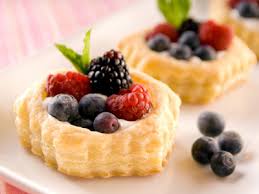记忆方法
将“pastry”与“pasty”对比记忆,想象“pastry”是一种制作更精细、层次更多、口感更好的食物,而“pasty”则是更加粗糙、简单的食物。通过这种对比,可以记住“pastry”指的是糕点或派皮。
以上内容由AI生成, 仅供参考和借鉴
中文词源
pastry 油酥面团,糕点
来自拉丁语pasta,面团,面食,-ry,名词后缀。引申词义糕点,油酥面团。
英语词源
- pastry
-
pastry: [16] The original word in English for ‘pastry’ in English was paste. This is still in use as a technical term, but in everyday usage it has gradually been replaced by pastry. This was derived from paste, modelled apparently on Old French pastaierie ‘pastry’, a derivative of pastaier ‘pastry cook’. It originally meant ‘article made from pastry’ (as in Danish pastries), and not until as recently as the mid- 19th century did it start being used for simply ‘pastry’.
=> paste - pastry (n.)
- mid-15c., "food made with paste," not originally limited to sweets, from Middle English paste (see paste (n.)) + -ry. Probably influenced by Old French pastaierie "pastry" (Modern French pâtisserie), from pastoier "pastry cook," from paste (see paste (n.)); also borrowed from Medieval Latin pasteria "pastry," from Latin pasta. Specific sense of "small confection made of pastry" is from 1906. Pastry-cook attested from 1712.
权威例句
- 1. I am partial to desserts that combine fresh fruit with fine pastry.
- 我偏爱加有新鲜水果的精致油酥甜点。
- 2. Can I tempt you with a little puff pastry?
- 我能给你尝点泡芙点心吗?
- 3. Trim off the excess pastry using a sharp knife.
- 用一把快刀切去多余的饼皮。
- 4. Making the pastry is a breeze if you have a food processor.
- 如果你有食品加工机,做这种点心轻而易举。
- 5. Roll out the pastry and cut into narrow strips.
- 把油酥面团擀薄然后切成长条。
